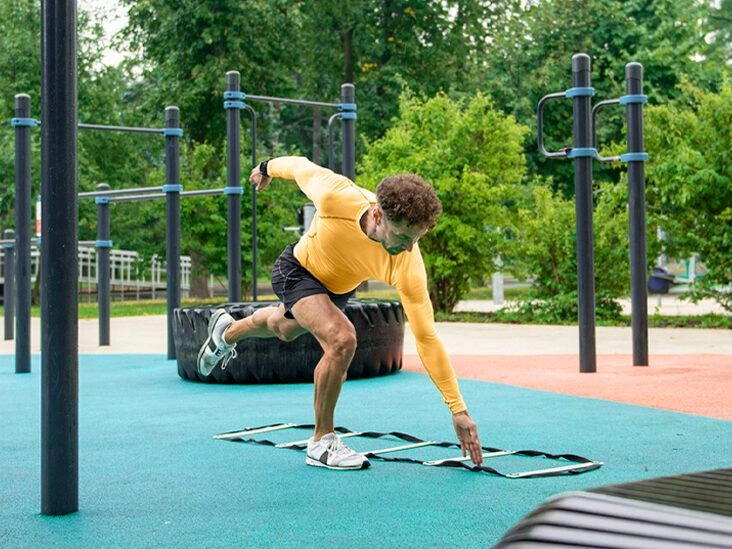Adductors play a key role in supporting your hips and lower body. Adding movements that specifically target these muscles can enhance mobility and lower the chance of getting hurt.
Having robust hips is essential for athletic performance, avoiding injuries, and preserving mobility as you grow older.
The adductors are a vital muscle group that help maintain hip strength and range of motion.
In strength training, the adductors are frequently neglected because they can be tricky to work effectively.
In this piece, we’ll explain what the adductors do, where they sit anatomically, several exercises to build them, and practical tips to consider when training them.
What are the adductors?
The adductors are a group of muscles located on the inside of your thighs that pull your legs toward the midline of your body.
This inward movement is called adduction — which should not be mixed up with “abduction,” meaning the opposite motion.
The adductor muscles attach from various spots on the pubic bone to multiple points on the femur. For this reason they’re commonly referred to as the “groin muscles.”
If you press your legs together, you’ll notice the muscles on your inner thigh engaging — those are the adductors.
SummaryThe adductors are a group of inner-thigh muscles responsible for drawing the legs toward the body’s midline.
Why are they important? What do they do?
Because the adductors, together with other leg muscles, are among the body’s larger muscle groups, they play a crucial role in everyday movements and sports-related activities.
Their main job is to provide lower-body stability during routine tasks like walking, climbing stairs, and squatting. They’re especially important during exercise.
Athletes rely on this muscle group to assist in explosive actions such as sprinting, jumping, and rapid lateral movements.
They also contribute to hip mobility, which is important for preventing injuries.
Regularly training your adductors prepares them for physical demands and can substantially reduce the likelihood of injury.
SummaryThe adductors primarily offer lower-body stability and hip mobility for everyday activities. Athletes depend on them for explosive actions like running, leaping, and side-to-side movement.
7 exercises to work your adductors
The adductors act as secondary stabilizers during many common lifts, including squats, deadlifts, box jumps, and sled pushes.
While performing those multi-joint movements will engage the adductors to some degree, you might want to target them directly to build strength and reduce injury risk.
Below are seven effective adductor-focused exercises — ranging in difficulty — you can add to your routine to specifically work your inner thighs.
Adductor machine
When people think of isolating the adductors, the traditional gym adductor machine often comes to mind.
Although this machine can effectively train the inner thigh, it isn’t the only way to make progress.
Because you can modify the resistance and pad spacing, this exercise is beginner-friendly.
Start with very light load to learn the movement and protect yourself from injury.
How to perform:
- Sit on the machine with the pads placed between your legs at a comfortable width, and set the resistance.
- Slowly squeeze your thighs together until the pads meet, feeling the muscles contract.
- Control the return to the starting position, allowing your thighs to move outward.
- Repeat for your desired sets and reps. If you’re new, try 2–3 sets of 10 reps.
Wide stance squat
The squat is often called the king of leg exercises because it recruits muscles across the entire lower body.
Among squat variations, the wide-stance — or sumo — squat particularly emphasizes the inner-thigh muscles.
You can perform this using a barbell, kettlebell, dumbbell, sandbag, or just body weight.
Here we’ll describe the wide-stance squat using only bodyweight.
How to perform:
- Place your feet wider than shoulder-width and turn your toes slightly outward.
- Shift your weight back and lower your hips until your thighs are roughly parallel to the floor.
- Push through the floor to return to standing, feeling your glutes and leg muscles, including the adductors, engage.
- Repeat for the desired sets and reps. Aim for 2–3 sets of 10–12 reps.

Standing banded adduction
Resistance bands are an excellent tool for isolating the adductors and training them from multiple angles.
Bands come in different lengths and resistance levels, making it simple to alter the challenge.
How to perform:
- Secure a resistance band to a sturdy anchor like a power rack or other anchored equipment.
- Stand with one side of your body facing the anchor and loop the band around your inner (working) foot.
- Adjust band tension by stepping further from the anchor or wrapping the band tighter.
- Let the band pull your leg outward while resisting that motion.
- From an upright position, draw your banded leg toward the center of your body, feeling the adductors contract.
- Slowly let the leg move back out under control.
- Switch legs and repeat for the desired sets and reps. Aim for 2–3 sets of 10–12 reps.

Seated banded adduction
The seated variation of the banded adduction is slightly easier because it demands less stability.
This makes it a great starting point for beginners who want to target their adductors.
How to perform:
- Anchor a resistance band to a solid point such as a rack or anchored equipment.
- Sit on a bench with one side of your body facing the anchor and the band.
- Place your inner foot through the band, positioning it just below the knee.
- Let the band pull your leg toward the anchor while you resist it.
- Bring the leg inward toward the body’s midline by contracting the adductors.
- Repeat for each leg until you reach the targeted sets and reps. Aim for 2–3 sets of 10–12 reps.

Side-lying adduction
This is a solid beginner movement that requires no equipment.
How to perform:
- Lie on your side on a mat with your spine neutral and hips stacked. Slide your bottom arm under your head and place your top hand on the floor in front of your abdomen.
- Bend the top knee so it points upward and set the foot flat on the floor in front of the bottom leg.
- Keep your bottom leg long and foot flexed, then lift it off the floor while contracting the adductors.
- Lower the leg slowly back to the mat with control.
- Repeat on the other side for the desired sets and reps. Aim for 10–12 reps and 2–3 sets.

Lateral lunge
The lateral lunge suits all fitness levels. Add dumbbells to increase difficulty if desired.
How to perform:
- Stand with feet hip-width apart.
- Step out to the right and sit your hips back as you bend the right knee. Use your arms forward for balance if helpful. During the descent, avoid letting the knee travel more than about 2 inches past the toes, and keep the knee tracking between the second and third toe. The stepping foot may turn slightly outward.
- Drive off the right foot to return to standing.
- Repeat on the left to complete one rep.
- Perform 2–3 sets of 10–12 reps per leg.

Copenhagen hip adduction
This move is suited for more advanced trainees. It isolates the adductors using bodyweight.
Strength athletes often use it as an accessory, and it’s also useful for athletes in other sports or anyone wanting to build inner-thigh strength.
Use care when attempting this exercise; it can place the adductors in a vulnerable position and may increase injury risk if done incorrectly.
How to perform:
- Begin in a side plank with one elbow on the floor or a pad and your legs aligned perpendicular to a weight bench.
- Rest your top leg on the bench with a slight bend in the knee, keeping the bottom leg straight beneath the bench. The higher your top leg rests on the bench, the more stable and less risky the position; resting only the ankle on the bench makes it much harder.
- Engage the adductors of the top leg to support your body weight and slowly lift the bottom leg until it contacts the underside of the bench.
- Lower your body back to the start position under control.
- After finishing the desired reps on one side, switch and work the other leg.
- Aim for 2–3 sets of 10–12 reps per leg.

SummaryThese seven adductor-focused exercises are a strong starting point for training your inner-thigh muscles. Begin with the simpler variations and progress to the more advanced options as your strength improves.
Training tips for adductor exercises
When working the adductors, a few key considerations can help you get better results and reduce injury risk.
Gradually increase range of motion
If you’re new to adductor training, begin with a smaller range of motion to minimize injury risk.
As you become stronger and more comfortable, slowly expand the range of motion and increase resistance to place greater demand on the muscles.
This approach helps prevent overstretching or straining an adductor during workouts.
Stretch and warm up
It’s generally wise to warm up before exercising to raise blood flow and body temperature, which can aid in injury prevention.
Many people do 5–10 minutes of low-intensity activity like walking or light cardio to get blood moving, then follow with mobility work.
Research indicates that dynamic (movement-based) stretches before exercise may be preferable to static stretches because they tend to preserve muscle strength.
Static stretching before strength training, conversely, can reduce muscle strength when done immediately prior.
Dynamic warm-up examples that activate the adductors include:
- front-to-back leg swings
- side-to-side leg swings
- jumping jacks
- bodyweight jump squats
Feel the contraction
Performing an exercise is one thing, but emphasizing contraction of the target muscle often yields better outcomes.
Evidence suggests that directing attention to the working muscle — the mind–muscle connection — can boost activation and potentially improve training results.
Beginners may find it challenging to develop this connection at first, so prioritize slow, controlled reps to help learn the movement and improve muscle engagement.
SummaryTo maximize the effectiveness of adductor training and reduce injury risk, progressively increase range of motion, perform a proper warm-up, and concentrate on feeling the muscle contract.
The bottom line
The adductors are a key inner-thigh muscle group that pull the legs toward the body’s center.
Their primary roles include offering stability during everyday tasks and supporting explosive athletic actions like jumping and sprinting.
While many compound movements engage the adductors, the seven exercises covered here are among the most practical to start with.
When training adductors, be sure to warm up properly, steadily increase range and resistance, and focus on the contraction to optimize results and prevent injury.
If you want to boost hip strength, improve mobility, or enhance sports performance, adding adductor-specific work to your program can be highly beneficial.


















Leave a Reply
You must be logged in to post a comment.